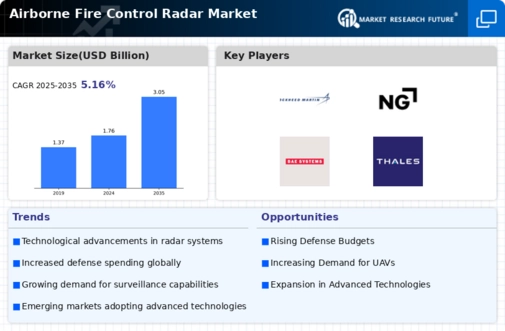Increased Defense Spending
The Airborne Fire Control Radar Market is significantly influenced by the trend of increased defense spending across various nations. Governments are allocating larger budgets to enhance their military capabilities, which includes upgrading existing radar systems and acquiring new technologies. This trend is particularly evident in regions with heightened geopolitical tensions, where nations are investing in advanced surveillance and targeting systems to maintain strategic advantages. For instance, defense budgets in several countries have seen increases of over 10% in recent years, directly impacting the procurement of airborne fire control radars. This financial commitment is likely to sustain the growth of the market, as defense contractors respond to the demand for more sophisticated and capable radar solutions.
Focus on Indigenous Development
The Airborne Fire Control Radar Market is witnessing a notable shift towards indigenous development of radar technologies. Many countries are emphasizing self-reliance in defense manufacturing, leading to the establishment of domestic production facilities for airborne fire control radars. This focus on indigenous capabilities not only reduces dependency on foreign suppliers but also fosters innovation and technological advancement within the local defense sector. Several nations have initiated programs to develop their own radar systems, which are tailored to meet specific operational requirements. This trend is expected to drive competition in the market, as local manufacturers strive to deliver high-quality products that can compete with established global players. The potential for collaboration between government and private sectors further enhances the prospects for indigenous radar development.
Rising Demand for Multi-Role Aircraft
The Airborne Fire Control Radar Market is benefiting from the rising demand for multi-role aircraft, which require advanced radar systems for effective operation. As military forces seek versatile platforms capable of performing various missions, the integration of sophisticated fire control radars becomes essential. Multi-role aircraft, such as fighter jets and surveillance planes, are increasingly equipped with advanced radar technologies to enhance their operational effectiveness. This trend is reflected in procurement strategies, where nations are prioritizing the acquisition of aircraft that can perform multiple functions, including air-to-air combat and ground attack. The market for airborne fire control radars is likely to expand as defense forces invest in upgrading their fleets to include these multi-role capabilities.
Emerging Threats and Security Concerns
The Airborne Fire Control Radar Market is significantly shaped by emerging threats and evolving security concerns. As geopolitical tensions rise and asymmetric warfare becomes more prevalent, the need for advanced surveillance and targeting systems is paramount. Airborne fire control radars play a crucial role in countering these threats by providing real-time situational awareness and enhancing engagement capabilities. Nations are increasingly recognizing the importance of investing in advanced radar technologies to address these challenges effectively. The market is expected to grow as defense agencies prioritize the development and procurement of systems that can detect and neutralize potential threats. This focus on security is likely to drive innovation and competition within the airborne fire control radar sector.
Technological Advancements in Radar Systems
The Airborne Fire Control Radar Market is experiencing a surge in technological advancements, particularly in radar systems. Innovations such as phased array technology and synthetic aperture radar are enhancing detection capabilities and target tracking. These advancements allow for improved accuracy and reliability in various operational environments. The integration of artificial intelligence and machine learning algorithms is also transforming data processing, enabling real-time analysis and decision-making. As nations prioritize modernization of their defense systems, the demand for advanced airborne fire control radars is expected to rise. Reports indicate that the market for airborne radar systems is projected to grow at a compound annual growth rate of approximately 5.2% over the next five years, reflecting the increasing reliance on sophisticated radar technologies.


















Leave a Comment